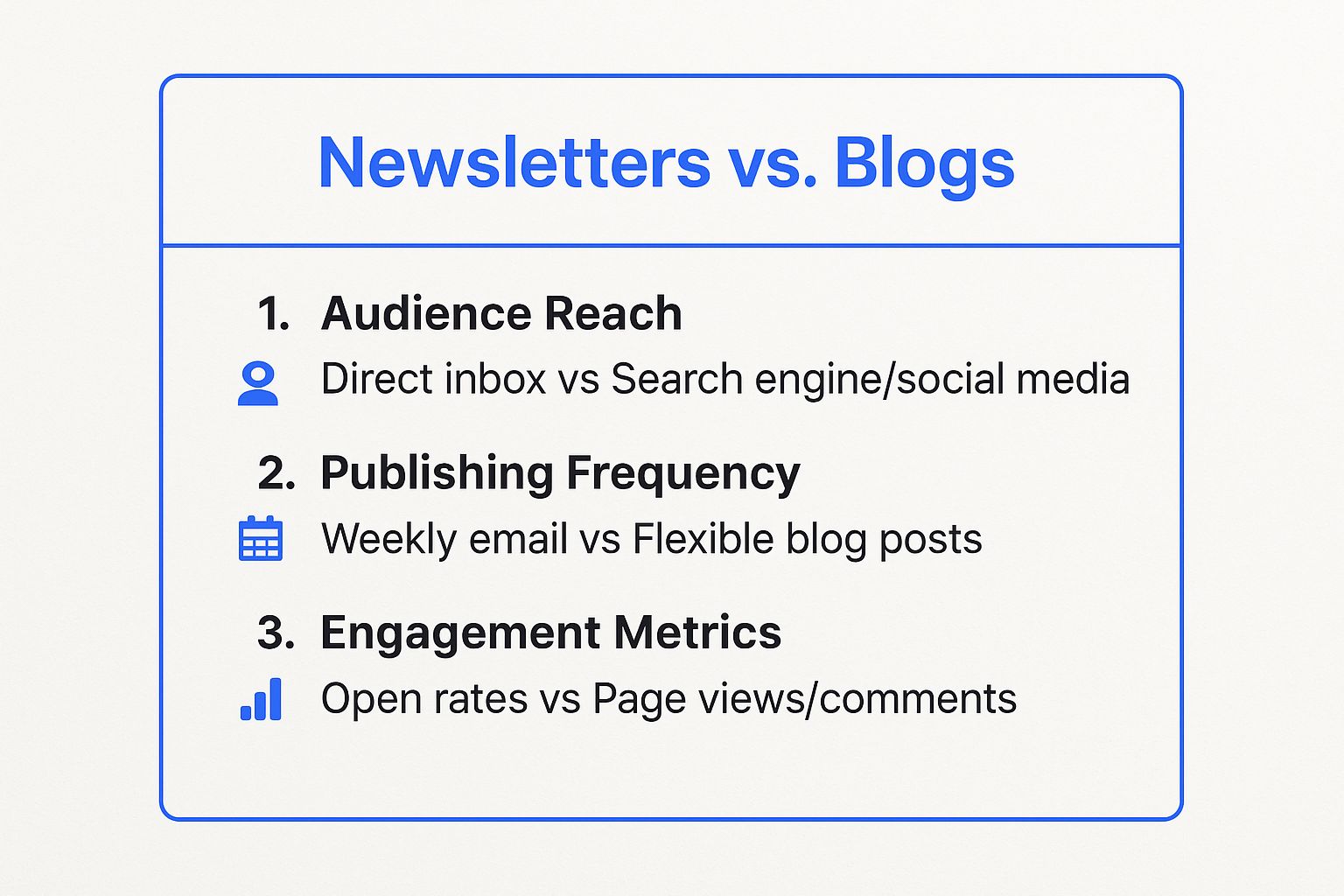Navigating the Content Landscape: Newsletter or Blog?
Choosing between a newsletter vs blog can be challenging. This article presents six content strategies to help you decide which platform, or combination of platforms, best suits your business needs in 2025. Discover whether direct engagement through a newsletter or organic reach with a blog will effectively elevate your content marketing. From comparison articles to live webinars, explore the options and find the right approach for you.
1. Comparison Articles
Deciding between a newsletter and a blog can be a tough call for businesses and content creators. Both offer unique advantages for reaching your audience and building a community. That's where comparison articles shine. These in-depth analyses systematically compare newsletters and blogs across crucial dimensions like audience reach, content distribution, monetization models, and engagement metrics. They provide a comprehensive, side-by-side evaluation to help readers make informed decisions about which format – or combination of formats – best suits their specific goals.
Comparison articles employ a structured framework, typically categorizing the key differences between newsletters and blogs. For instance, a common comparison point is content distribution. Newsletters deliver content directly to subscribers' inboxes, offering a controlled and personalized experience. Blogs, on the other hand, rely on search engines and social media for discoverability, casting a wider net but potentially reaching a less engaged audience. Another key area of analysis is monetization. Newsletters often utilize subscription models or sponsored content, while blogs might leverage advertising, affiliate marketing, or the sale of digital products.
Successful comparison articles incorporate data-driven analysis, presenting statistics and metrics to illustrate the strengths and weaknesses of each format. They often use visual elements like comparison tables and charts to make the information more digestible. Objectivity is paramount, fairly presenting both the pros and cons of each platform. Ultimately, these articles aim to offer actionable recommendations based on different reader scenarios and use cases. For example, a comparison article might suggest newsletters for businesses prioritizing direct communication with a loyal customer base, while recommending blogs for businesses seeking to establish thought leadership and attract organic traffic. You can learn more about Comparison Articles for further insights.
HubSpot's "Email Newsletter vs Blog: Which Should You Choose?" comprehensive guide exemplifies the effectiveness of this approach. Similarly, Buffer’s detailed comparison posts analyzing various social media strategies and ConvertKit's in-depth analysis of email marketing versus content marketing demonstrate the value of structured comparisons in helping audiences navigate the complex digital landscape. These resources provide valuable insights, data, and real-world examples to guide strategic decision-making.
Pros of using comparison articles:
- Comprehensive Overview: Offers a complete overview of both formats in a single resource, saving readers time and effort.
- Informed Decision-Making: Facilitates quicker, more informed decisions by presenting key information in a structured format.
- SEO Benefits: Comparison articles are inherently SEO-friendly, ranking well for comparison-based search queries.
- Repurposing Potential: Content can be repurposed across multiple platforms, maximizing reach and impact.
- Authority Building: Creating high-quality comparison articles positions you as an authority and expert on the topic.
Cons of using comparison articles:
- Research Intensive: Requires thorough research and fact-checking to ensure accuracy and objectivity.
- Maintenance: Can become outdated quickly as platforms evolve, requiring regular updates.
- Oversimplification: May oversimplify complex nuances and individual circumstances.
- Bias Risk: There's a risk of appearing biased toward one format, even unintentionally.
Tips for creating effective comparison articles:
- Use consistent evaluation criteria for a fair and balanced comparison.
- Include real metrics and case studies to support your claims.
- Create visual comparison tables for easy scanning and comprehension.
- Address specific reader scenarios and use cases to provide tailored recommendations.
- Update regularly to maintain accuracy and relevance.
Influential figures like Brian Dean (Backlinko), Neil Patel, Ann Handley (MarketingProfs), and Jay Baer (Convince & Convert) have popularized and championed the use of comparison articles in digital marketing and content strategy.
The following infographic visualizes key differences between newsletters and blogs focusing on audience reach, publishing frequency, and engagement metrics.

The infographic provides a quick reference summarizing the core distinctions: newsletters offer direct inbox reach, while blogs rely on broader channels; newsletters tend towards regular, scheduled publishing, whereas blogs offer more flexibility; and engagement is measured by open rates for newsletters versus page views and comments for blogs. These key takeaways highlight the varying strengths of each platform depending on your specific communication goals. Choosing the right format, or a strategic combination of both, depends on your target audience, content strategy, and overall business objectives. By understanding these differences, content creators can make informed decisions about how to best engage their audience and achieve their marketing goals. "newsletter vs blog" remains a frequently searched term, underscoring the importance of clear, comparative resources.
2. Video Tutorials and Explainers
Choosing between a newsletter and a blog can feel overwhelming, especially when trying to understand the nuances of each. Enter video tutorials and explainers: a dynamic medium that brings the "newsletter vs blog" debate to life. These educational videos leverage the power of visuals – screen recordings, animations, live presentations – to demonstrate the practical differences between the two formats, making abstract concepts tangible and easier to understand. They offer a powerful way to break down complex information and show real examples of newsletters and blogs in action, ultimately simplifying your decision-making process.
Imagine seeing a screen recording of someone setting up an email automation sequence for their newsletter, followed by a side-by-side comparison of that process with scheduling a blog post on WordPress. This visual demonstration eliminates guesswork and provides a concrete understanding of the workflows involved in each platform. This is precisely the value proposition of video tutorials and explainers in the "newsletter vs blog" discussion.
Video tutorials provide a wealth of features that enhance learning and engagement. Visual demonstrations of both formats, including screen recordings showcasing actual platforms like Mailchimp or WordPress, provide viewers with a clear understanding of how each works. Step-by-step implementation guides offer practical, actionable advice viewers can immediately apply. Real-time audience interaction through comments fosters a sense of community and allows for immediate feedback and clarification. Furthermore, the dynamic nature of video allows creators to showcase complex elements like email automation or website analytics in a way that static text simply can't replicate.
The benefits of video tutorials are numerous. They boast higher engagement rates than text-based content, capturing attention and fostering a deeper understanding. Complex concepts, such as SEO optimization for blogs or A/B testing for newsletters, are easier to grasp when presented visually. Moreover, video content is easily repurposed across multiple platforms like YouTube, Facebook, and Instagram, maximizing reach and impact. This format also caters to visual and auditory learners, offering a more accessible and engaging learning experience. Finally, the personal connection fostered by seeing and hearing a presenter builds trust and rapport with the audience.
Consider the success of creators like Pat Flynn of Smart Passive Income, whose YouTube tutorials on email marketing and online business strategies have helped millions. Similarly, Amy Porterfield’s video courses offer in-depth comparisons of various content strategies, including newsletters and blogs. Graham Stephan, known for his real estate content, also uses video to break down his content strategy, demonstrating the effectiveness of this medium for diverse audiences. These examples highlight the power and reach of video tutorials and explainers.
Despite the advantages, video tutorials have some drawbacks. Creating high-quality videos requires video production skills and equipment, which can be a barrier to entry for some. The process is also more time-intensive than writing a blog post or newsletter, encompassing filming, editing, and post-production. Updating video content when information changes can be challenging, potentially requiring re-shoots or edits. Finally, video may not be accessible to all audiences due to bandwidth limitations or disabilities.
To maximize the effectiveness of your video tutorials and explainers when comparing newsletters and blogs, consider these tips: Utilize screen recordings to demonstrate actual platforms in action. Include timestamps for easy navigation within the video. Provide downloadable resources or templates that viewers can use to implement the strategies discussed. Create a series format for comprehensive coverage of the "newsletter vs blog" topic, exploring various facets in each installment. Finally, optimize your videos for both YouTube and social media platforms to ensure maximum visibility. Learn more about Video Tutorials and Explainers
Whether you're a small business owner, digital marketing professional, independent blogger, or non-technical entrepreneur, understanding the differences between newsletters and blogs is crucial for a successful online presence. Video tutorials and explainers offer an engaging, effective, and accessible way to navigate this often confusing landscape. By showcasing real-world examples, practical implementation steps, and the pros and cons of each platform, these videos empower you to make informed decisions about your content strategy.
3. Case Study Deep Dives
When deciding between a newsletter vs blog, real-world examples can offer invaluable guidance. Case study deep dives provide a powerful way to understand the nuances of each platform by examining the successes (and failures) of others. These in-depth analyses go beyond surface-level observations, offering a detailed look at how specific businesses or creators have leveraged newsletters or blogs to achieve their goals. They dissect the strategies employed, the tools utilized, the results achieved, and the lessons learned, providing concrete evidence of what works in the competitive digital landscape.
Case studies offer a compelling blend of theory and practice. Instead of simply presenting abstract concepts, they showcase how these principles are applied in real-world scenarios. This makes them incredibly valuable for understanding the practical implications of choosing a newsletter vs blog for your specific needs. By analyzing the journey of others, you can glean actionable insights and avoid common pitfalls.
A robust case study deep dive typically includes several key features:
- Real Performance Data and Metrics: This goes beyond vanity metrics like follower count. It delves into engagement rates, conversion rates, subscriber growth, and other key performance indicators (KPIs) that demonstrate the actual impact of the chosen strategy.
- Timeline of Strategy Implementation: Understanding the chronological progression of a successful (or unsuccessful) campaign is crucial. It helps identify key milestones, turning points, and the overall evolution of the strategy.
- Specific Tactics and Tools Used: Knowing what was done is important, but knowing how it was done is even more valuable. Case studies should detail the specific tools, platforms, and tactics employed, offering readers a practical roadmap to replicate successful strategies.
- Measurable Outcomes and ROI Analysis: Ultimately, success is measured by results. Case studies should quantify the return on investment (ROI) achieved through the newsletter or blog strategy, demonstrating the tangible benefits of the approach.
- Interview Quotes from Practitioners: Adding the voice of the individuals behind the strategies provides invaluable context and insights. Direct quotes from practitioners offer a personalized perspective and often reveal the challenges and triumphs experienced along the way.
The benefits of using case studies to inform your newsletter vs blog decision are numerous:
- Provides Credible, Evidence-Based Insights: Data-driven analysis adds weight to the findings, making the insights more convincing and trustworthy.
- Shows Practical Application of Theories: Case studies bridge the gap between abstract concepts and practical application, demonstrating how theories translate into real-world results.
- Builds Trust Through Transparency: Openly sharing data and methodologies fosters transparency and builds credibility with the audience.
- Offers Replicable Strategies: Well-structured case studies provide actionable steps that readers can adapt and implement in their own businesses.
- Appeals to Data-Driven Decision Makers: The quantitative nature of case studies resonates with those who value data-backed insights and measurable results.
However, there are also some potential drawbacks to consider:
- Requires Access to Proprietary Data: Obtaining detailed data can be challenging, especially for privately held companies.
- Results May Not Be Universally Applicable: What works for one business may not work for another. Context and market conditions play a significant role.
- Time-Intensive Research and Verification Process: Conducting thorough case study research requires significant time and effort.
- May Become Outdated Quickly: The digital landscape is constantly evolving, so case studies can become outdated if not regularly updated.
Examples of impactful case studies include analyses of Morning Brew's newsletter growth, Tim Ferriss's blog monetization strategy, The Hustle's acquisition by HubSpot, and ConvertKit's creator success story analyses. These studies provide a wealth of information for anyone grappling with the newsletter vs blog dilemma. Learn more about Case Study Deep Dives
When using case studies to guide your strategy, consider these tips:
- Focus on Specific, Measurable Outcomes: Prioritize data that demonstrates tangible results.
- Include Both Successes and Failures: Learning from mistakes is just as important as celebrating successes.
- Provide Context About Market Conditions: The success of a strategy is often influenced by external factors.
- Make Strategies Actionable for Readers: Provide clear, concise steps that readers can follow.
- Follow Up with Long-Term Results When Possible: Tracking long-term impact provides a more complete picture of a strategy's effectiveness.
Popularized by growth marketing experts like Ryan Holiday, Sean Ellis, Rand Fishkin, and Dharmesh Shah, the use of case studies has become a cornerstone of effective digital strategy. By leveraging these in-depth analyses, you can gain a deeper understanding of the newsletter vs blog debate and make informed decisions that drive results for your own business.
4. Interactive Decision Trees and Quizzes
Choosing between a newsletter and a blog can feel overwhelming, especially when both offer unique advantages for connecting with your audience and achieving your business goals. Interactive decision trees and quizzes offer a dynamic and personalized approach to help navigate this decision, guiding users towards the format best suited for their specific needs. They present a series of targeted questions about the user's objectives, resources, and content preferences, using branching logic to arrive at a tailored recommendation.

These interactive tools work by presenting users with a series of questions, often in a multiple-choice format. Each answer influences the subsequent questions, creating a personalized path through the decision tree. For example, a user aiming to build a strong community might be asked about their preferred communication style, while a user focused on lead generation might be asked about their existing marketing infrastructure. This branching logic ensures that users receive relevant advice based on their individual circumstances. Upon completion, the quiz provides a personalized recommendation – either newsletter or blog – along with a rationale explaining the reasoning behind the suggestion.
This approach offers several advantages over static advice. First, it creates a highly engaging and interactive experience for users. Rather than passively reading information, they actively participate in the decision-making process, leading to increased investment and a greater sense of ownership over the outcome. Second, it delivers personalized value to each user, ensuring that the advice they receive is directly relevant to their specific situation. This tailored approach strengthens user engagement and increases the likelihood of them following the recommendation. Finally, quizzes offer powerful lead generation capabilities. By requiring users to submit their email address to receive their personalized results, businesses can capture valuable leads for future follow-up and nurture campaigns.
Several successful examples demonstrate the effectiveness of this approach in the "newsletter vs blog" debate. HubSpot's Marketing Grader offers an interactive assessment that analyzes a user's website and marketing efforts to provide tailored recommendations. Typeform provides templates specifically for creating content strategy quizzes, allowing users to easily build their own interactive decision trees. CoSchedule's suite of content marketing assessment tools helps users identify their ideal content mix, including newsletters and blog posts. OptinMonster leverages interactive quizzes for conversion optimization, guiding users towards the content formats most likely to convert them into subscribers or customers. These tools illustrate the versatility and effectiveness of interactive quizzes for guiding content strategy decisions.
While interactive decision trees and quizzes offer significant benefits, they also present certain challenges. Developing these tools can be technically demanding, requiring either coding skills or specialized software. Crafting comprehensive decision logic can also be complex, requiring careful consideration of various user scenarios and potential responses. Furthermore, quizzes may sometimes oversimplify nuanced decisions, failing to capture the full complexity of individual situations. Regularly updating the quiz content and logic is also crucial to maintain accuracy and relevance.
For those looking to implement this approach, several tips can ensure success. Keep the questions simple, relevant, and focused on the core decision of "newsletter vs blog." Provide detailed explanations with the results, clearly outlining the reasoning behind the recommendation. Include actionable next steps or resources to help users implement the chosen strategy. Thoroughly test the quiz with real users before launching to identify any flaws or areas for improvement. Finally, track completion rates and user feedback to continually optimize the quiz for maximum effectiveness. Popular online marketers like Ryan Levesque (Ask Method), Russell Brunson (ClickFunnels), Noah Kagan (AppSumo), and Ramit Sethi (I Will Teach You to Be Rich) have effectively used this method to engage audiences and guide them towards specific product or service offerings.
This approach deserves its place in the "newsletter vs blog" discussion because it empowers users to make informed decisions based on their unique circumstances. By providing a personalized, engaging, and actionable experience, interactive decision trees and quizzes bridge the gap between general advice and individual needs. Learn more about Interactive Decision Trees and Quizzes For small business owners, digital marketing professionals, bloggers, and entrepreneurs, these tools offer a valuable resource for navigating the complexities of content strategy and choosing the right format to achieve their goals.
5. Expert Interview Series
One powerful strategy to truly understand the "newsletter vs blog" debate is to learn directly from those who have successfully navigated both worlds. An expert interview series offers a unique opportunity to glean insights from successful newsletter creators, blog owners, and content marketing experts. These structured conversations delve into their experiences, strategies, and perspectives on leveraging newsletters and blogs for maximum impact. By tapping into this wealth of knowledge, you can gain a more nuanced understanding of which platform best suits your specific needs and goals.

An expert interview series typically involves a Q&A format, allowing you to address common concerns and gain behind-the-scenes insights not readily available elsewhere. This approach provides a platform for diverse perspectives from various industries, offering a well-rounded understanding of the newsletter vs blog dynamic. Think of it as a curated panel of experts sharing their successes, failures, and lessons learned, all geared towards helping you make informed decisions about your own content strategy. This format deserves its place in this list due to its unique ability to bridge the gap between theory and practice, providing real-world examples and actionable advice.
Features of a well-executed expert interview series include: first-hand expertise from successful practitioners, diverse perspectives across different industries, a Q&A format that addresses common concerns, behind-the-scenes insights, and networking opportunities for both the interviewer and the interviewees. For instance, the Tim Ferriss Show regularly features interviews with successful creators across various domains, offering a wealth of knowledge on building and engaging an audience. Similarly, the Smart Passive Income podcast, hosted by Pat Flynn, frequently features email marketing experts discussing the nuances of newsletter strategy. Other examples include the Content Marketing Institute's expert interview series led by Joe Pulizzi and Nathan Barry's ConvertKit creator interviews. These resources showcase how effective interview series can be in disseminating valuable information and fostering a sense of community.
The benefits of conducting an expert interview series are numerous. It builds credibility by associating your brand with recognized experts in the field. It provides unique, exclusive content that draws in your target audience. Moreover, it creates networking opportunities, allowing you to connect with influential figures in your industry. Presenting multiple perspectives on the same topic offers a more comprehensive understanding of the newsletter vs blog debate. Finally, the content generated from these interviews can be repurposed across multiple formats, such as blog posts, social media snippets, and email newsletters.
However, there are also potential drawbacks. Coordinating schedules with multiple interviewees can be challenging. The quality of the content heavily depends on the interviewee's participation and willingness to share valuable insights. Maintaining a consistent structure across different interviews can also be difficult. Finally, there's the potential for conflicting advice, which can leave the audience confused.
To maximize the effectiveness of your expert interview series, consider these tips: Prepare specific, insightful questions in advance. Research interviewees' backgrounds thoroughly to tailor your questions to their expertise. Focus on eliciting tactical advice and specific examples, rather than general observations. Create a consistent format across interviews to provide a cohesive experience for your audience. Finally, follow up with written summaries or transcripts to make the content easily accessible and shareable. You can learn more about Expert Interview Series and developing a robust content marketing strategy overall to integrate your findings. By meticulously planning and executing your expert interview series, you can unlock a wealth of knowledge and empower your audience to make informed decisions about their own content strategy within the "newsletter vs blog" landscape.
6. Live Webinar Sessions
Choosing between a newsletter and a blog for your content marketing can be tricky. Both offer unique benefits, and understanding which platform best suits your goals is crucial. One powerful way to bridge the gap and gain clarity on this decision is through live webinar sessions focusing specifically on the "newsletter vs blog" debate. These real-time, interactive presentations provide an engaging platform for content marketing experts to dissect the nuances of each medium, answer audience questions, and offer personalized advice. This approach deserves a place on this list due to its ability to provide in-depth, tailored guidance and foster direct interaction with a targeted audience.
Live webinar sessions function as virtual classrooms where attendees can learn about the specific strengths and weaknesses of newsletters and blogs. The sessions usually involve a presentation component led by an expert, demonstrating the core features of each platform and highlighting how they can be leveraged for different marketing objectives. For instance, a presenter might demonstrate how to build an email list using a newsletter platform like ConvertKit or how to optimize blog posts for SEO. The real-time interaction aspect is a key differentiator, allowing attendees to ask specific questions related to their unique situations and receive immediate feedback. This interactivity makes webinars a far more personalized learning experience compared to static content like blog posts or pre-recorded videos.
Several platforms offer features specifically designed to facilitate effective webinar sessions. These features include real-time interaction with the audience through chat functionalities, live demonstrations of relevant tools and platforms like Mailchimp or WordPress, dedicated Q&A sessions addressing specific audience concerns, screen sharing for practical examples, and recording capabilities for later viewing and repurposing. The availability of recordings allows attendees to revisit the session at their convenience and also extends the reach of the content to those who couldn't attend the live event.
Numerous organizations and individuals successfully utilize live webinars to educate their audience about content marketing strategies, including the "newsletter vs blog" dilemma. ConvertKit's weekly creator workshops, for example, often cover topics related to building an audience and monetizing content, frequently touching on the strategic use of both newsletters and blogs. Mailchimp's small business marketing webinars also delve into the effective use of email marketing within a broader content strategy. HubSpot Academy's live training sessions provide a comprehensive overview of inbound marketing principles, including best practices for both blogging and email marketing. Social Media Examiner's weekly shows, hosted by Michael Stelzner, explore various aspects of social media marketing and often integrate discussions on the role of newsletters and blogs within a holistic digital strategy.
If you are considering incorporating live webinars into your content marketing strategy to help your audience navigate the "newsletter vs blog" choice, here are some actionable tips:
- Promote extensively across multiple channels: Leverage your social media presence, email list, and website to announce your webinar and drive registrations.
- Prepare backup plans for technical issues: Have a contingency plan in place in case of internet outages or software glitches. This might involve having a co-host ready to take over or providing pre-recorded content as a fallback.
- Include interactive polls and surveys: Engage your audience throughout the session by incorporating interactive elements like polls and surveys to gather feedback and tailor the content in real-time.
- Follow up with attendees after the session: Send a follow-up email with a recording of the webinar, additional resources, and a call to action. This reinforces the learning experience and provides opportunities for further engagement.
- Create a series format for ongoing engagement: Consider developing a series of webinars on related topics to cultivate a loyal audience and provide ongoing value.
While live webinars offer numerous advantages, it’s important to be aware of the potential drawbacks: They require technical setup and platform management, are limited to specific time zones and schedules, have the potential for technical difficulties, and require strong presentation skills from the host.
Despite these challenges, the benefits often outweigh the drawbacks. Live webinars offer direct engagement with audience questions, build personal connections and trust, address specific use cases in real-time, possess high perceived value due to the live format, and can generate qualified leads through registration. Influential figures in the content marketing space, such as Nathan Barry (ConvertKit), Michael Stelzner (Social Media Examiner), Marcus Sheridan (They Ask, You Answer), and Ann Handley (MarketingProfs), have popularized the use of webinars for educational and marketing purposes, demonstrating their effectiveness in engaging audiences and delivering valuable insights. If you're aiming to provide a dynamic and interactive learning experience surrounding the complexities of choosing between a newsletter and a blog, live webinars are a powerful tool to consider.
Content Format Comparison: Newsletter vs Blog
| Format | Implementation Complexity 🔄 | Resource Requirements ⚡ | Expected Outcomes 📊 | Ideal Use Cases 💡 | Key Advantages ⭐ |
|---|---|---|---|---|---|
| Comparison Articles | Medium - Needs extensive research | Moderate - Data gathering, writing | Comprehensive, data-driven evaluations | Educating readers choosing between newsletters/blogs | Comprehensive overview; SEO-friendly; authority building |
| Video Tutorials and Explainers | High - Video production skills | High - Equipment, editing | High engagement; clear concept demonstration | Visual learners; demonstrating complex ideas | Engaging; multi-platform repurposing; personal connection |
| Case Study Deep Dives | High - Access to data, verification | Moderate to High - Research, interviews | Credible, evidence-based insights; ROI analysis | Data-driven decision makers; practical strategy examples | Builds trust; replicable strategies; transparent results |
| Interactive Decision Trees & Quizzes | High - Technical development | High - Development tools, maintenance | Personalized recommendations; lead generation | Customized guidance; lead capture | Highly engaging; personalized; social sharing potential |
| Expert Interview Series | Medium – Coordination and scheduling | Moderate - Interview prep, recording | Exclusive insights; multiple expert perspectives | Thought leadership; expert advice | Builds credibility; unique content; networking |
| Live Webinar Sessions | High - Live setup and management | High - Platform and presentation skills | Real-time interaction; personalized advice | Interactive Q&A; community building | Direct engagement; trust building; lead generation |
Making Your Choice: Newsletter, Blog, or Both?
Choosing between a newsletter vs blog can be a crucial decision for your content strategy. Throughout this article, we've explored various resources from comparison articles and video tutorials to expert interviews and interactive quizzes, all designed to help you navigate this decision. We've seen how blogs excel at long-form content, SEO, and attracting organic traffic, while newsletters foster a direct connection with your audience, offering personalized updates and driving conversions. The key takeaway? The "best" choice depends entirely on your specific business goals, audience, and available resources.
Mastering these concepts is invaluable for anyone looking to grow their online presence, whether you're a small business owner, a digital marketing professional, or an independent creator. A well-defined content strategy, utilizing the right platforms, can significantly impact your reach, engagement, and ultimately, your bottom line. In 2025, a truly effective approach often involves leveraging the strengths of both newsletters and blogs. Consider your bandwidth and audience preferences when making your decision. Remember, a powerful combination of organic reach and direct engagement can lead to exponential growth.
Want to streamline your content strategy and leverage the power of both newsletters and blogs? BlogMaker seamlessly integrates these functionalities, offering a one-stop solution for creating, distributing, and managing your content. Explore the possibilities and take your content strategy to the next level by visiting BlogMaker today.
SEO–ready, Analytics, No–code.
Your Content Publishing Engine
Deliver your SEO–driven content!
Visit BlogMaker.app



